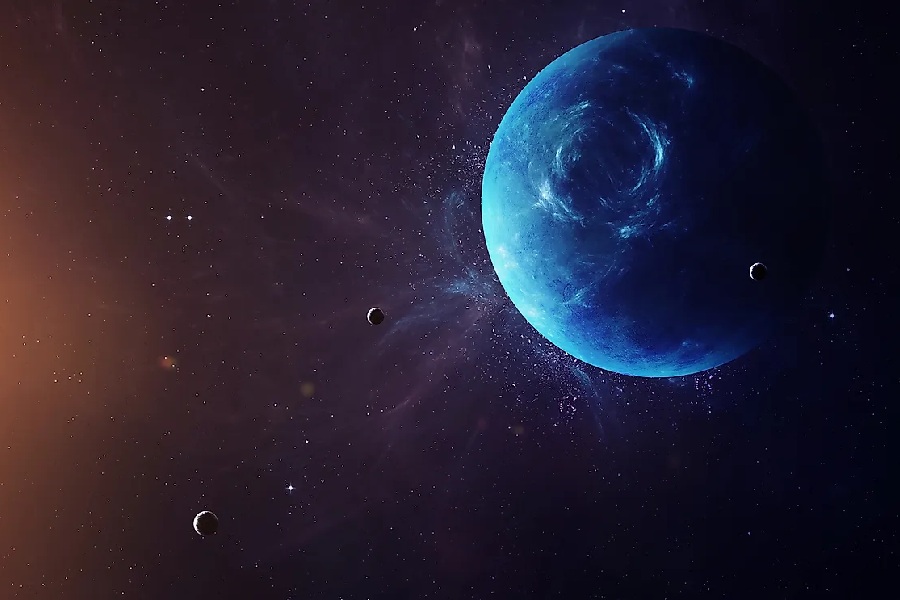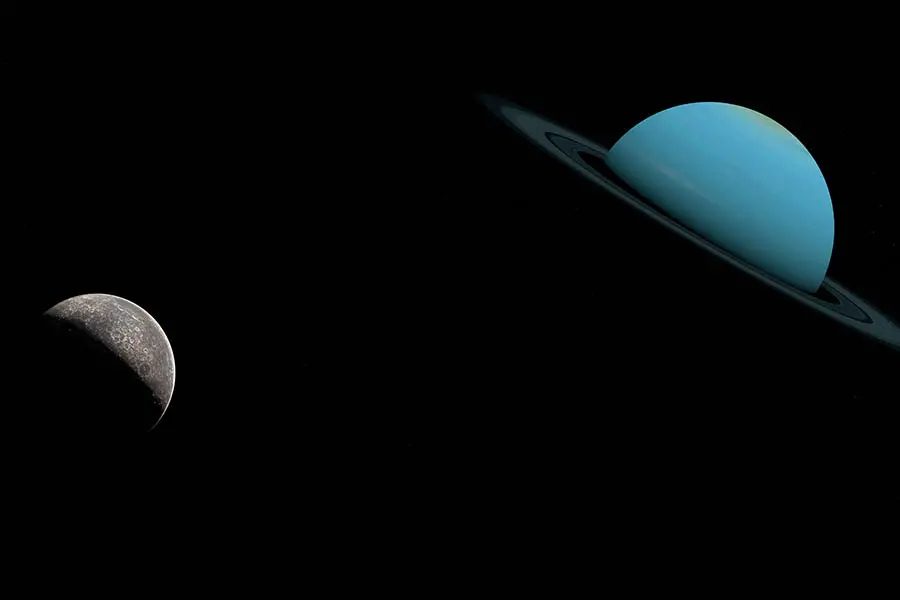Neptune, the farthest planet from the Sun, has a system of moons that hold fascinating secrets. Though distant and difficult to study, these natural satellites offer tantalizing clues about the origins and nature of our solar system.
What do we know about these small, cold worlds so far from Earth? How were they formed, and what have we learned about them so far? Recent advances are helping us unravel more facts about Neptune’s mysterious moons.
New horizons beckon as we develop the technology and techniques to reveal additional details about these tiny, distant orbs. What further insights can they provide into Neptune and the far frontier of our cosmic neighborhood? Join us as we explore some intriguing facts about Neptune’s moons.

Facts About Neptune’s Moons
- Neptune has 14 confirmed moons, the largest being Triton.
- Neptune’s moon, Triton, is unique among large solar system moons in that it orbits Neptune in a retrograde direction.
- Neptune’s moons are likely remnants of the planet’s formation that were captured rather than forming in orbit around it.
- The moons range in size from less than 31 miles (50 kilometers) in diameter to over 3100 miles (5000 kilometers) for Triton.
- Several of Neptune’s moons exhibit unusual behaviors like chaotic rotation (Nereid) or unexpected orbital inclinations (Halimede, Sao, Laomedeia).
- Neptune’s moons were discovered by William Lassell who was a key 19th-century astronomer.
- The discovery of Triton helped solve mysteries about Neptune and revealed Triton’s unique retrograde orbit.
The Largest Neptune’s Moon – Triton – Was Discovered By William Lassell
William Lassell was a skilled engineer who built his own telescopes and pioneered new mirror-making techniques. He founded an observatory dedicated to studying the planets.
Only weeks after Neptune’s discovery in 1846, Lassell observed the planet and detected its large moon Triton. This was a very significant contribution to the field of planetary science at the time. Triton was unlike other large moons in the Solar System in its unique characteristic – it orbits against the rotation of Neptune.
This retrograde motion led scientists to believe Triton may originally have been a captured Kuiper belt object. Lassell’s detection greatly expanded knowledge about Neptune’s satellites and the planet itself.
The discovery highlighted open questions about the origins and nature of Neptune’s moons that scientists continue working to understand today.
Other Neptunian moons discovered by William Lassell
Additional moons detected
In 1851, Lassell detected Ariel and Umbriel, two more of Neptune’s moons. His observations revealed the unexpected complexity of Neptune’s system. Lassell’s dedication to studying the planets led to revelations that shaped early knowledge of ice giants.
Lassell was one of the most talented planetary astronomers of the 19th century. With his pioneering outer planet observations, Lassell greatly expanded insights into the nature of gas/ice giants and their satellite systems. His work laid the foundation for future generations to unravel outer solar system mysteries.
Pioneering planetary astronomer
Lassell built innovative telescopes that allowed him to discover new details about distant worlds. His breakthrough observations of Uranus, Neptune and their moons transformed early awareness of the outer solar system’s architecture.
Lassell inspired many future astronomers through both his technological brilliance and deep cosmic insights.
There Are 2 Types of Neptunian Moons
Neptune’s 14 moons can be divided into two groups:
- 7 irregular outer moons, including Triton
- 7 regular inner moons
The regular inner moons follow circular prograde orbits in Neptune’s equatorial plane. The irregular outer moons generally have eccentric, inclined, and often retrograde orbits far from Neptune, except Triton, which has a circular but retrograde, inclined orbit close to Neptune.
Irregular outer moons
Triton is the largest captured irregular moon. Its unique circular, retrograde orbit and composition similar to Pluto support the Kuiper belt object origin. Analysis of tidal heating and geology provides insights into Neptune’s past and dwarf planet evolution.
Nereid has the most highly inclined, eccentric orbit indicating dramatic orbital changes under Neptune’s gravity over billions of years. Past tidal heating may have driven geological activity similar to Triton. Its battered surface reveals a violent collisional history.

Small, distant irregular moons
Halimede, Nereid, Sao, Laomedeia, Psamathe, and Neso orbit far from Neptune in eccentric, inclined paths revealing their captured origins. Little is known beyond their orbital parameters. More small, distant irregular moons likely exist and await discovery to further decipher Neptune’s complex dynamical environment over solar system history.
Regular inner moons
The seven regular inner moons are Naiad, Thalassa, Despina, Galatea, Larissa, Hippocamp, and Proteus.
Naiad and Thalassa orbit Neptune within the inner Galle/Le Verrier ring. It is thought that these small moons act as shepherds to the ring and are a source of material to replenish the ring. The interactions between the ring and the moons remain an area of active study.
Despina and Galatea orbit just beyond Neptune’s innermost Le Verrier/Adams ring complex.
Scientists are interested to know how these two irregularly shaped moons maintain their orbits so close to Neptune and how they influence nearby ring structures through gravitational resonances and perturbations. Galatea’s brightening and dimming as it rotates offers additional insight into the moon’s surface composition and geology.
The other inner moons exhibit similar luminosity variations to a lesser extent, providing clues to the internal structure and collisional histories across this class of Neptunian moons as a whole.
Characteristics of Neptunian Moons
- Orbit Neptune at various distances
- Interact with rings and atmosphere
- Range greatly in size and mass
- Can have prograde or retrograde orbits
- Often contain substantial water ice
Neptune’s moons constitute a diverse system of natural satellites exhibiting a wide span of salient qualities. These characteristics illuminate the moons’ origins and evolutionary pathways while granting insights into Neptune’s environment across space and time.
Detailed analysis of the moons’ varied features, including orbital dynamics, compositions, and physical parameters, informs theories about the Neptunian system’s deeper mysteries. Progress mapping this complex satellite environment advances a broader understanding of ice giants.
Eccentric orbits around Neptune
Most Neptunian moons follow eccentric rather than circular orbits, shaped by gravitational dynamics over billions of years. Extreme ellipse-shaped trajectories result in unusual effects, including orbital instability and heating, that profoundly impact moon environments.
Mapping the mechanisms underlying orbital eccentricity grants insights into the chaotic early history of planet migration that dispersed Neptune’s satellites into their present paths. The moons’ discordant orbits provide clues about a still-unfolding narrative.
Influence on Neptune’s upper atmosphere & rings
Multiple Neptunian moons exhibit complex interactions with Neptune’s tenuous outer atmosphere and ring systems. Shepherd moons help gravitationally confined rings while processes like meteoroid blast-offs and magnetospheric ion emissions from moons shape atmospheric structure.
Charting the multifaceted moon-atmosphere-ring dynamics aids models of the pathways by which Neptune’s rings formed and evolved over time. As with eccentric orbits, associated analyses grant wider awareness of ice giants’ complex natural satellite environments.
Ability to contain water ice
Frigid Neptunian moons with surfaces below -328°F (-200°C) can accumulate and preserve abundant icy envelopes, with some consisting of nearly 50% water ice. This aids understanding of the original distribution of ice in the early outer Solar System during Neptune’s formation.
Studying processes shaping subsurface liquid layers with the potential to nurture exotic aquatic biospheres provides an impetus for ice-moon exploration. Findings about the prevalence of water ice environments inform models of habitability beyond Earth.
Retrograde orbits compared to prograde orbits
Most regular satellites exhibit prograde orbits, spinning in Neptune’s rotational direction. However, Triton and Nereid showcase highly tilted retrograde orbits, signaling origins as captured objects. Contrasting the two trajectory classes provides information about the moons’ distinct evolutionary pasts.
Prograde orbits imply condensation from Neptune’s initial circumplanetary disk, while retrograde paths support gravitational capture theories. Comparative analyses enhance comprehension of the poles’ wanderings played in configuring icy worlds.
Variations in size & mass from moon to moon
Spanning just over 3100 miles in diameter for giant Triton down to minute sub-kilometer moons, Neptune’s satellites showcase an immense spectrum of sizes. Similarly, calculated masses range across orders of magnitude from Triton at over 2 x 2250 pounds (1022 kilograms) down to diminutive new-found moons.
Documenting the extensive variability in physical attributes aids models of the different formation scenarios required to explain such diversity within a single satellite system. It highlights the complex sequence of events throughout Neptune’s long history.
Conclusion
The 14 confirmed Neptune’s moons constitute a profoundly diverse and dynamic system of natural satellites. As we have seen, analyzing their myriad qualities and behaviors grants deep insights into the mysteries of the Neptunian system’s origins and evolution.
We hope you have realized through these facts about Neptune’s moons how the intricate dance of influences between planets and moons unveils important clues about the history of our solar system’s outer frontier.
This article has helped you better understand the revelations emerging from steadily advancing observations of freezing worlds in the farthest reaches of the Sun’s realm.
As astronomers continue elucidating exciting new facts about Neptune’s moons, these tiny, distant orbs will contribute to ever more magnificent comprehension of environments at the Solar System’s edge.
